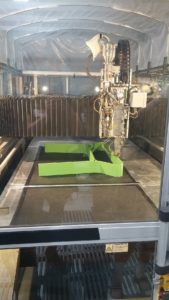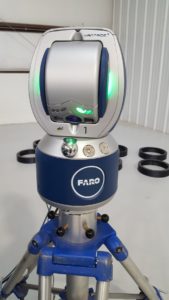Additive Engineering Solutions: A Small Company with a Big 3D Printer
 Additive Engineering Solutions (AES) may be a small company, but it has one of the biggest 3D printers in the world. When 3DPrint.com Editor-in-Chief Sarah Goerhke and I walked into the company’s headquarters in Akron, Ohio yesterday, the first thing we saw was the massive Big Area Additive Manufacturing, or BAAM, machine hard at work in the middle of the room.
Additive Engineering Solutions (AES) may be a small company, but it has one of the biggest 3D printers in the world. When 3DPrint.com Editor-in-Chief Sarah Goerhke and I walked into the company’s headquarters in Akron, Ohio yesterday, the first thing we saw was the massive Big Area Additive Manufacturing, or BAAM, machine hard at work in the middle of the room.
“It’s 3D printing a table,” AES President and Co-Founder Austin Schmidt told us with a smile. “We’re hoping to serve drinks on it later.”
A few hours later, the 3D printed, bright green table would indeed sit among the attendees at AES’ open house, several of them resting food and beverages on top of it. A look around the warehouse showed that the AES staff has been enjoying using the BAAM, which they acquired in December: 3D printed trash cans, stools, chairs, and additional tables filled the space along with prototypes the team has been working on.
When Schmidt and Vice President/Co-Founder Andrew Bader started AES in August 2015, they never planned to own a giant 3D printer – they never intended to own a 3D printer at all, actually. Their mission was to begin a 3D printing consulting business, which would design for 3D printing but rely on service bureaus to provide the actual prints. That changed, however, when Schmidt, who was working for Caterpillar at the time, visited Oak Ridge National Laboratory (ORNL) and saw the work they were doing with the BAAM.
 At the time, there were only 12 BAAMs in existence, with none of them available for commercial contract use. Schmidt saw an opportunity and pitched the idea to Bader: the company had a chance to provide a service that no one else was offering. While large-scale additive manufacturing has been growing in recent months, it was still scarcely available as recently as a year ago. In April of 2016, with the help of Bader’s family business, OGS Industries, the young company made the decision to invest in a BAAM from Cincinnati Inc. and become a provider of large-scale 3D printed parts.
At the time, there were only 12 BAAMs in existence, with none of them available for commercial contract use. Schmidt saw an opportunity and pitched the idea to Bader: the company had a chance to provide a service that no one else was offering. While large-scale additive manufacturing has been growing in recent months, it was still scarcely available as recently as a year ago. In April of 2016, with the help of Bader’s family business, OGS Industries, the young company made the decision to invest in a BAAM from Cincinnati Inc. and become a provider of large-scale 3D printed parts.
AES has been operational since January of this year, and the BAAM has been 3D printing since February. Just a couple of weeks ago, the company also acquired a Quintax 5-axis CNC router, which was also operating during the open house. A FARO 3D scanner was on display, as well.
- Quintax CNC router
- FARO 3D scanner
Schmidt and Bader addressed the open house’s attendees, which included representatives from BAAM developers ORNL and Cincinnati Inc. among several other businesses, many of them local. Staying local is important to AES; according to Schmidt, 90% of the company’s funds have gone to Ohio companies so far.
At the moment, AES only has three full-time employees, but they’re extremely hard-working employees who have built up a strong customer base already. It hasn’t been easy: part of the challenge, said Bader, is that people simply don’t know that large-scale additive manufacturing services exist. AES has been doing a lot of outreach, and we heard from a couple of their customers, starting with Joe Lettieri of Goodyear’s research and development department.
“There were two things I wanted as a child: a Star Wars lightsaber and a Star Trek Replicator,” he said.
Lettieri came to realize that if he had a Replicator, he could make his own lightsaber. Part of his dream was dashed when he learned that he’d need kyber crystals for a real working lightsaber – but Replicators came along in the form of 3D printing. Goodyear began using the technology about 25 years ago, but it would take days to 3D print a single part.
“25 years later, time has heightened value,” he said. “The pace of the world is quickening.”
Machines like the BAAM are meeting that pace, capable of 3D printing massive parts in 24 hours or less. Lettieri went on to describe the two key strategies he sees as being vital to a successful business: advanced prototyping and co-location. A full-scale prototype allows customers to get firsthand experience of the final part before the final part exists, while the co-location of “critical people and resources” provides a huge competitive advantage. One of those critical resources, of course, is a BAAM.
“Both of these strategies,” he concluded, “converge at AES.”
Next up was Dr. Kirk Rogers of GE Additive. He outlined what he sees as the five levels of additive manufacturing:
- 0: the creation of tools, fixtures and prototypes
- 1: the replacement of traditionally manufactured parts with 3D printed ones
- 2: designing and redesigning to take advantage of what additive manufacturing offers
- 3: the integration of different parts that wouldn’t necessarily go together otherwise
- 4: 4D printing
He praised AES as a small company helping larger companies, describing a “symbiotic relationship” between AES and GE Additive.
“We help them grow, and they help us with technological advancement,” he said.
He remarked on the speed of AES’ turnaround vs. that of larger, more long-established companies. It’s not just having a BAAM that gives AES a competitive advantage, it’s also an energy, drive and a laser focus on customer satisfaction that small, young companies so frequently exhibit. Often, it’s these small companies that truly end up changing the landscape of their industries.
After brief remarks from Akron Mayor Daniel Horrigan, we were able to walk around the facility some more, and see a 3D printed stool raffled off (I did not win, sadly). We also had the opportunity to interview Schmidt and Rogers to go more in-depth on AES and GE Additive.
It’s hard to gauge a company before meeting its people and seeing its facility, so AES’ open house was a great opportunity to experience a growing, local company. AES has a lot going for it: energy, passion, determination, and dedication, just to name a few of the attributes that were clearly evident upon arrival. Not to mention a really big 3D printer.
Share your thoughts in the Additive Engineering Solutions forum at 3DPB.com.
[Photos: Sarah Goehrke]
Subscribe to Our Email Newsletter
Stay up-to-date on all the latest news from the 3D printing industry and receive information and offers from third party vendors.
Print Services
Upload your 3D Models and get them printed quickly and efficiently.
You May Also Like
Printing Money Episode 28: Recent M&A and More with Joris Peels, 3DPrint.com
Welcome to Episode 28 of Printing Money. For this one Danny is joined by our own, Joris Peels (Executive Editor, 3DPrint.com). This crossover-pod is indeed quite meta-level but it’s not...
3DPOD 251: 3D Printing for Football Helmets with Kodiak Brush, LIGHT Helmets
Kodiak Brush grew up playing football before working on crash testing. Sometimes someone’s career can seem like it is inexorably building up to one goal. And with Kodiak now making...
3DPOD 250: Dieter Schwarze, Nikon SLM Solutions
Dieter Schwarze is a true 3D printing icon. Here we get the twisting, arduous tale of Dieter’s journey into additive. Starting with inkjet, SLA and lots of other technologies, Dieter´s...
3DPOD 249: One Million Part 3D Printing Orders and More with Spencer Loveless, Merit3D
Spencer Loveless’ story is a compelling one. It’s a tale of a family business starting from nowhere and becoming successful. Then subsequently, it is a tale of manufacturing in the...




































